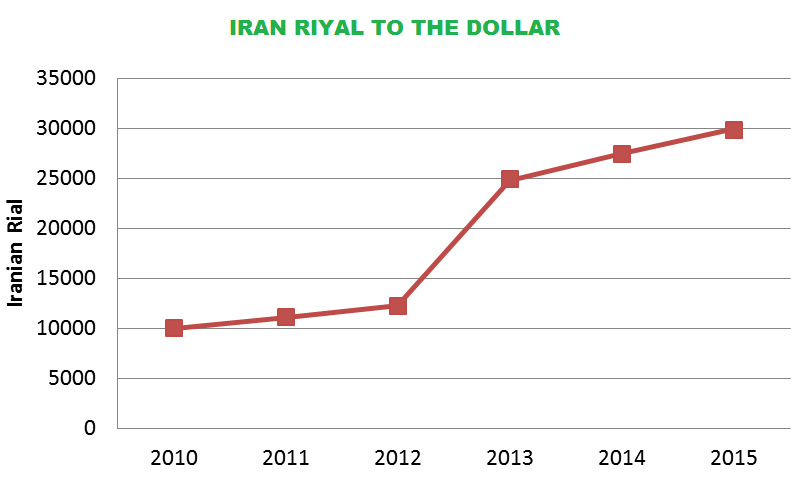Iran Riyal Collection Notes
The
Iran riyal was first introduced in 1798 as a coin worth 1250 dinar or one eighth
of a toman. In 1825, the rial ceased to be issued, with the qiran of 1000
dinars (one tenth of a toman) being issued as part of a decimal system. The rial
replaced the qiran at par in 1932, although it was divided into one hundred
(new) dinars.
Prior to decimalisation in 1932, these coins and currencies were used, and some
of these terms still have wide usage in Iranian languages and proverbs
In 1932, the exchange rate with the British pound was 1 pound = 59.75 rial. This
changed to 80.25 in 1936, 64.350 in 1939, 68.8 in 1940, 141 in 1941 and 129 in
1942. In 1945, Iran switched to the U.S. dollar as the peg for its currency,
with 1 dollar = 32.25 rial. The rate was changed to 1 dollar = 75.75 rial in
1957. Iran did not follow the dollar’s devaluation in 1973, leading to a new peg
of 1 dollar = 68.725 rial. The peg to the U.S. dollar was dropped in 1975.

In 1979, 1 rial equaled $0.0141. The value of Iran’s currency declined
precipitously after the Islamic revolution because of capital flight from the
country. Studies estimate that the flight of capital
from Iran shortly before and after the revolution is in the range of $30 to
$40 billion. Whereas on 15
March 1978, 71.46 rials equaled one U.S. dollar, in July 1999, 9430 rials
amounted to one dollar.
Injecting sudden foreign exchange revenues in the economic system forms the
phenomenon of “Dutch disease” in a country. There are two main consequences for
a country with Dutch disease: loss of price competitiveness in its production
goods, and hence the exports of those goods; and an increase in imports. Both
cases are clearly visible in Iran.
The solution is to direct the extra revenues from oil into the National
Development Fund for use in productive and efficient projects.
Although described as an (interbank) “market rate”, the value of the Iranian
rial is tightly controlled by the central bank. The state ownership of oil
export earnings and its large reserves, supervision of letters of credit,
together with current – and capital outflow account – outflows allows management
of demand. The central bank has allowed the rial to weaken in nominal terms
(4.6% on average in 2009) in order to support the competitiveness of non-oil
exports.
There is an active black market in foreign exchange, but the development of the
TSE rate and the ready availability of foreign exchange over 2000 narrowed the
differential to as little as IR100 in mid-2000.[17]
However the spread increased again in September 2010 because channels for
transferring foreign currency to and from Iran are blocked because of
international sanctions.
Monetary policy is facilitated by a network of 50 Iranian-run forex dealers in
Iran, the Middle-East and Europe. According to the WSJ and dealers, the Iranian
government is selling $250 million daily to keep the Iranian rial exchange rate
against the US dollar between 9,700 and 9,900 (2009). At times (before the
devaluation of the rial in 2013) the authorities have chosen to weaken the
national currency intentionally by withholding the supply of hard currency to
earn more rial-denominated income, usually at times when the government faces a
budget deficit.
The widening of the gap between official and unofficial exchange rates in 2011
stands at over 20% (as of November 2011). This shows the correlation between the
value of foreign currencies and the domestic inflationary environment.
The unofficial rial vs. US dollar rate underwent severe fluctuations in January
2012 (losing 50% of its value in a few days, following new international
sanctions against the CBI), eventually settling at 17,000 rials at the end of
the period. Besides all the bad effects on the economy in general, this had the
effect of boosting the competitiveness of Iran’s domestic industries abroad.
Following President Ahmadinejad’s decision to liberalize the mechanism by which
bank interest rates are set (granting banks the authority to raise interest
rates to 21%),CBI
announced that it would be fixing the official rate of the rial against the
dollar at 12,260 rials from 28 January 2012 and seek to meet all demand for
foreign currency through banks.
On September 25, 2012, the Iranian rial fell to a new low, trading at 26,500 to
the US dollar. The drop followed the government’s launch of a foreign exchange
center a day before, that would provide importers of some basic goods with
foreign exchanges, at a rate about 2% cheaper than the open market rate on a
given day. The announced rate at the center on September 24, 2012 was 23,620
rials to USD. By early October 2012, Rial had further fell in value to about
38,500 Rials per USD in the free market. The Iranian rial was officially
devalued in July 2013
